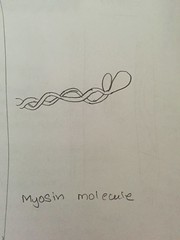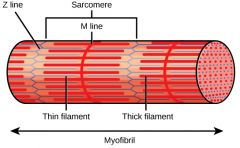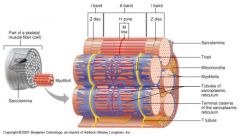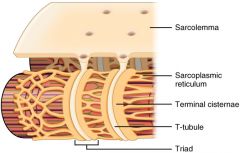![]()
![]()
![]()
Use LEFT and RIGHT arrow keys to navigate between flashcards;
Use UP and DOWN arrow keys to flip the card;
H to show hint;
A reads text to speech;
162 Cards in this Set
- Front
- Back
- 3rd side (hint)
|
Function of skeletal muscle?(4) |
Movement maintain posture/body position stabilize joints thermogenesis |
|
|
|
how does skeletal muscles provide movement? |
muscles attach directly/indirectly to bone, pull on bone or tissue when they contract. |
|
|
|
How does Skel muscle maintain posture/body position? |
muscles are continuously contracting to make adjustments to maintain posture |
|
|
|
How does Skel muscles stabilize joints? |
tendons crossing joints/muscle tone |
|
|
|
how does skel muscle provide thermogenesis? |
generate heat when contracting |
|
|
|
how are muscles excitable? |
respond to nerve stim. |
|
|
|
how are muscles contractible? |
they shorten when stim. |
|
|
|
how are muscles extensible? |
they can stretch beyond resting length when relaxed. |
|
|
|
how are muscles elastic? |
they can recoil/rebound to original resting length after contraction or stretching. |
|
|
|
What is endomysium? |
CT wrapping that surrounds individual muscle fibers |
|
|
|
What is perimysium? |
CT wrapping that surrounds bundles of muscle fibers called fascicles |
|
|
|
What is epimysium? |
Dense irregular CT wrapping that surrounds the entire muscle (final wrapping) |
|
|
|
muscle fiber=? |
Muscle cell |
|
|
|
What is the Sarcolemma? |
the plasma mem. surrounding the muscle fiber (cell) |
|
|
|
What is the sarcoplasm? |
the cytoplasm of the muscle fiber it uses a lot of ATP |
What does it use a lot of? |
|
|
What does the sarcoplasm contain? |
A lot of mitochondria, glycogen, myoglobin and contractile organelles called myofibrils |
|
|
|
myoglobin gives muscles what? |
their pigment similar to hemoglobin uses O2 |
|
|
|
What is a myofibril? What direction does it run? |
long finger-like organelle that fills the sarcoplasm of the cell. runs parallel to muscle fiber |
|
|
|
What is a sarcomere? |
A segment on a myofibril aligned end to end along the length of the myofibril Has a Z-line |
|
|
|
What is a Z-Line? |
boundary at the end of each sarcomere |
|
|

|
|
|
|
|
What is a myofilament? |
contractile proteins in the sarcomere arrangement gives muscles its striations |
|
|
|
What is Myosin filaments? |
Thick filaments |
|
|
|
describe myosin filaments |
tail with split head arragned in bundles |
|
|
|
What does the head of myosin have? |
-ATP binding site -ATPase enzyme that splits ATP to provide energy during contraction -Actin binding site |
|
|

|
|
|
|
|
What is Actin filament? |
thin filament |
|
|
|
What is actin attached to? |
attached to Z-line and extends towards the center of sacromere |
|
|
|
What does Actin contain? |
the active binding site for myosin heads |
|
|

|

|
|
|
|
What proteins regulate the binding of myosin? |
Tropomyosin and Troponin |
|
|
|
What is Tropomyosin? |
a protein that regulates the binding of myosin. it spirals around actin, blocks active site when muscle is relaxed. |
|
|
|
what protein blocks active binding site when muscle is relaxed |
Tropomyosin |
|
|
|
What is Troponin? |
a protein that regulates the binding of myosin contains 3 binding sites |
|
|
|
What are the 3 things that bind to troponin? |
-Actin -tropomyosin (controls its position on active binding site) Ca2+ |
|
|
|
What are titin (elastic) filaments? |
large protien attached to Z-line and runs through the center of thick filaments |
|
|
|
What does titin filaments do? |
gives muscle elastic property uncoils when muscle stretches yet stiffens to avoid over extension recoils when muscle relaxes |
|
|
|
What is Sarcoplasmic reticulum (SR)? |
specialized smooth endoplasmic reticulum |
|
|
|
What does SR sourround? |
each myofibril |
|
|
|
what is the terminal cisternae? |
expanded ends of SR |
|
|
|
what does SR store/release? |
Ca2+ and releases it when muscle fiber is stim. to contract |
When does it release it? |
|
|
What are transverse tubules (t-tubule)? |
deep indentations of the sarcolemma into the muscle fiber |
|
|
|
where are t-tubules located? |
lie between 2 terminal cisternae |
|
|
|
What do t-tubules do? |
conduct electrical impulses from sarcolemma into the muscle fiber coordinates muscle contraction by triggering Ca2+ release from the terminal cisternae |
|
|

|

|
|
|
|
In order to contract a skel muscle must... |
-be stim. by somatic motor nueron -propagate an electrical current, or AP, along its sarcolemma -have a rise in intracellular Ca2+ levels(the final trigger for contraction) |
3 things |
|
|
Linking the electrical signal to the contraction is? |
excitation-contraction coupling |
|
|
|
What is the neuromuscular junction formed from? |
Axon terminals synaptic cleft motor end plate |
|
|
|
what do the axon terminals contain? |
they have synaptic vesicles that contain acetylcholine (ACh) |
|
|
|
What is the synaptic cleft filled with? |
neurotransmitters for ACh |
|
|
|
Where is the motor end plate located? |
its a specific part of the sarcolemma |
|
|
|
What does the motor end plate contain? |
ACh receptors |
|
|
|
What happens when a nerve impulse reaches the end of an axon at the neuromuscular junction? |
-voltage-regulated Ca2+ channels open and allow Ca2+ to enter axon. -Ca2+ inside the axon terminal causes vesicles to fuse with the axon membrane and release ACh into the synaptic cleft by exocytosis. |
|
|
|
At the neuromuscular junction what diffuses across the cleft? |
ACh diffuses across cleft and binds to ACh receptors on motor end plate. |
|
|
|
What happens when ACh binds to ACh receptors on motor end plate? |
initiates an AP in the muscle |
|
|
|
After the AP is initiates in the muscle what happens to ACh? |
ACh bound to ACh receptors is quickly destroyed by acetylcholinesterase |
|
|
|
ACh binding to receptors at neuromuscular junction opens what kind of channels? |
Na+ channels ad Na+ rushes in. |
|
|
|
in excitation-contraction coupling: what happens once the AP is generated? |
1)it is propagated along the sarcolemma 2)travels down the T tubules 3)triggers Ca2+ release from terminal cisternae 4)Ca2+ binds to troponin |
|
|
|
In excitation-contraction coupling when Ca2+ binds to troponin what happens? |
-a conformational change in troponin -tropomyosin rolls off the actin active binding sites allowing them to be exposed for the myosin to attach |
|
|
|
What blocks the actin active binding sites? (excitation-contraction coupling) |
tropomyosin |
|
|
|
What wants to bind to actin? (excitation-contraction coupling) |
myosin |
|
|
|
Is there is no Ca2+ can myosin bind? |
NO |
|
|
|
what is sliding filament theory? |
once myosin grabs actin and you have pulling of actin |
|
|
|
steps in sliding filament theory |
-cross bridge formation -working (power) stroke -cross bridge detachment -"cocking" of the myosin head |
|
|
|
what happens in cross bridge formation? |
the myosin cross bridge attaches to actin filament (has energy from ATP) |
|
|
|
What happens in the working (power) stroke? |
the myosin head pivots and pulls actin filament toward M line |
|
|
|
What happens in cross bridge detachment? |
new ATP attaches to myosin head and the cross bridge detaches |
|
|
|
What happens in cocking of the myosin head? |
energy from hydrolysis of ATP cocks the myosin head into the high-energy state. |
|
|
|
What happens when nerve stimulation ceases? (muscle relaxation) |
-Ca2+ is removed and actively transported back into SR (requires ATP) -Tropomyosin roles back over the binding sites and muscle fibers relax (myosin cant grab actin) |
|
|
|
Tension definition |
force muscle exerts on an object when contracted |
|
|
|
what is the opposing force exerted on the muscle? |
load or resistance |
|
|
|
what must overcome the force of the load in order to shorten? |
muscle tension |
|
|
|
what are the phases of muscle contraction (3) |
-latent period -period of contraction -period of relaxation |
|
|
|
latent period of muscle contraction |
1st few milliseconds, excitation-contraction coupling |
|
|
|
period of contraction of muscle contraction |
when cross bridge cycling tension increases (filament are sliding) |
|
|
|
period of relaxation of muscle contraction |
when Ca2+ is transported back into SR, cross bridge cycling ends, tension decreases |
|
|
|
individual mscle fiber contractions are what kind of a response? |
"all or none" |
|
|
|
whole muscle contactions can vary in _______ produced and ______ of contraction. |
tension, length |
|
|
|
graded muscle responses are: |
-variations in the degree of muscle contraction -required for proper control of skel movement |
|
|
|
graded muscle responses are graded by: |
-changing the frequency of stim. -changing the strength of the stim. |
|
|
|
what are the factors that effect muscle tension? (4) |
Intensity of stim frequency of stim size of muscle optimal operating length |
|
|
|
In factors effecting tension what does the intensity of stim have to do with? |
has to do with the number of motor units stim |
|
|
|
motor unit? |
a single motor neuron and all the muscle fibers that it supplies |
|
|
|
what is recruitment? |
it has to do with motor units. it is calling more motor units therefor stim more fibers and increasing muscle tension |
|
|
|
what is threshold stim? |
it is the min. stim needed to invoke visible contraction |
|
|
|
what is max stim? |
it is when all motor unit are recruited, strognest contraction produced |
|
|
|
what is asychronous recruitment? |
its alternating the motor units |
|
|
|
In factors effecting tension what is involved in the frequency of stim? |
Twitch wave summation complete tetanus |
|
|
|
what is twitch? |
a single impulse a contraction followed by relaxation |
|
|
|
what is a wave summation? |
when impulses are delivered in succession the 2nd twitch will be stronger than the 1st. |
|
|
|
What is complete tetanus? |
a rapid stimulation results is sustained smooth contraction without periods of relaxtion |
|
|
|
Refactory period in skel muscle |
contractile response lasts longer, far beyond the refactory period of the AP importan in skel muscles ability to produce tetaus |
|
|
|
what is Treppe? |
the staircase effect its the increased contraction in response to multi stim of the same length |
|
|
|
how is treppe different than summation? |
relaxation occurs in treppe |
|
|
|
in treppe why do contractions increase? |
-there is increasing availability of Ca2+ in the sarcoplasm (keeps sending AP) -reduced slack of the elastic series component -muscle enzyme systems become more effiecient because heat is increased as muscle conteracts |
|
|
|
In factors effecting tension the size of the muscle has to with? |
-# of muscle fibers per muscle -size of individual muscle fibers-fibers produce more myofilaments in response to demands placed on them. |
|
|
|
In factors effecting tension the optimal operating length has to do with? |
the resting length in which max contraction an be generated (70-130%) occurs when muscle is slightly stretched and filaments barley overlap |
|
|
|
isotonic |
same tension -muscle tension remains constant during contraction -muscle length changes during contraction, shortens or legnthens |
|
|
|
types of isotonic contractions |
concentric eccentric |
|
|
|
concentric isotonic contraction |
muscle shortens and does work |
|
|
|
eccentric isotonic contraction |
muscle contracts as it legnthens helps counteract gravity or prevent joint injury "muscle braking" |
|
|
|
what are isometric contractions? |
same legnth -tension increases but muscle legnth remains the same -muscle in unable to produce enough force to overcome the load |
|
|
|
what is muscle tone? |
-constant low level of tension in relaxed mucles -maintained by spinal reflexes that activate alternating motor units -keeps muscles firm and ready to respond to stim. |
|
|
|
Role of ATP in skel muscle? |
muscles need constant supply of ATP to carry out contractions. -cross bridge formation, power stroke -disconnecting cross bridges -active transport of Ca2+ back into terminal cisternae -Na+/K+ pump |
|
|
|
how much ATP do muscles store? |
for a 4-6 second contraction |
|
|
|
what must be constantly regenerated for muscle contractions? |
ATP |
|
|
|
what are the 3 pathways tat supply additional ATP for muscle contraction? |
-Creatine phosphate (direct phosphorylation) -oxidative phosphorylation -glycolysis |
|
|
|
what happens in direct phosphorylation? |
Creatine phosphate transfers energy and a phosphate to ADP forming ATP (Creatine phosphate + ADP*-----* creatine + ATP) - |
|
|
|
Where is Creatine phosphate stored? |
in muscle fibers |
|
|
|
how much energy is produced from diect phosphorylation (Creatine phosphate) |
provides a rapid source of energy 10-15 seconds of contraction |
|
|
|
howdo muscles prefer to get ATP? |
through Oxidative phosphorylation (aerobic respiration) |
|
|
|
where does Oxidative phosphorylation occur? |
in the miochondria |
|
|
|
what is the main source of ATP when O2 is present? |
Oxidative phosphorylation |
|
|
|
what fuels Oxidative phosphorylation? |
glycogen stores and glucose and fatty acids delivered by the blood |
|
|
|
how much energy is produced from Oxidative phosphorylation? |
can provide hours of muscle contraction for prolonged moderate activity. |
|
|
|
is Oxidative phosphorylation fast or slow? |
slower because it requires the delivery of O2 and glucose |
|
|
|
Are there any limits to the amount of nutrients that can be delivered to mucles? |
yes, there are cardiovascular limits. -CV cant keep up with O2 demands -BV in the muscles are compressed during max contraction (hinders nutrient delivery) -Oxidative phosphorylation may not be able to keep up and produce enough ATP to keepup with demands |
|
|
|
is glycolysis anaerobic or aerobic? |
anaerobic (NO O2) |
|
|
|
what happens in glycolysis? |
glucose is broken down to pyruvec acid and produces 2 ATP with no O2 pyruvec acid is converted to lactic acid |
|
|
|
glycolysis creates how much ATP |
produces minimal amounts of ATP but does it quickly provides 30-60 seconds of high level activity |
|
|
|
define fatigue |
decline in muscle tension as a result of previous activity |
|
|
|
when are muscles unable to contract despite being stim? |
in fatigue |
|
|
|
what does fatigue result from? |
deficient amount of ATP |
|
|
|
what is the process that happens in fatigue? |
-anaerobic respiration becomes less efficient as lactic acid accumulates and pH drops in the muscle fiber -muscle fibers lose K+ as the Na-K pump is unable to restore ion balance since it requires ATP
|
|
|
|
what is neuromuscular fatigue? |
not caused by a shortage of ATP but a shortage of neurotransmitters at the neuromusclar junction |
|
|
|
what is oxygen debt? |
its the amount of extra O2 the body must take in to restore muscle chemistry back to a resting state |
|
|
|
how does Oxygen debt occur? |
-liver converts lactic acid i blood to pyruvate acid which can be converted into glucose to enter aerobic respiration now that O2 is available -glycogen stores are replenished in muscles and liver. -creatine is re-phosporylated into creatine phosphate and stored in muscles -O2 rebinds to myoglobin |
|
|
|
how do muscle fibers differ in their methods of metabolism? |
-pathways to produce ATP duration of muscle contrction -how quickly their ATPases work speed of contraction |
|
|
|
slow--oxidative muscle fibers (red) |
slow to contract but most resistant to fatigue -good for endurance/continuous contraction -better equipped for oxidative phosphorylation lots of mitochondria/smaller in diameter high myoglobin content -slow myosin ATPase activity |
|
|
|
Fast--oxiative muscle fibers (pink) |
fast to contract but resistant to fatigue -equippd for oxidative posphorylation -fast myosin ATPase activity (better at adaptation) |
|
|
|
fast--glycolytic fibers (white) |
fast to contract but fatigue quickly -good for power and speed for short duration -high glycogen reserves and relie mainly on glycolysis -fatigue quicky cause of lactic acid build up -large fibers geneneate more force but poor nutrient diffusion -light in color due to reduced myoglobin -fewer capillaries and mitochondria |
|
|
|
Aerobic exercise (effects of exercise on muscle fibers) |
results in more efficient muscle metabolism and resistance to fatigue -increases capillaries, mitochondria and myoglobin -also increases efficiency of the heart, lungs, body metabolism and neuromuscular coordination |
|
|
|
resistance-weight lifting and isometric contractions (effects of exercise on muscle fibers) |
fibers produce more myofilaments and myofibrils causing muscle fibers to hypertrophy -increases glycogen stores results in increased muscle size and strength |
|
|
|
What is smooth muscle composed of? |
spindle-shaped fibers organized into 2 layers (longitudinal and circular) except stomach has 3 layers |
|
|
|
Where is smooth muscle found? |
in walls of hallow organs (except heart) |
|
|
|
smooth muscle lack what? |
neuromuscular junctions |
|
|
|
smooth muscle have innervating nerves that have __________ swellings called_______ that release ________ |
bulbous,varicosities, neurotransmitters |
|
|
|
Are smooth muscle nuerotransmitters excitatory or inhibitory? |
some are excitatory and some are inhibitory depending on the receptor |
|
|
|
what is the difference of SR in smooth muscle compared to skel muscle? |
the SR in smooth muscle is less developed and lacks a certain pattern with in the cell |
|
|
|
Do Smooth muscles have t-tubules? |
NO |
|
|
|
what is the difference in the thin filaments of smooth muscle compared to skel muscle? |
the thin filaments only have tropomyosin, there is NO troponin. |
|
|
|
in smooth muscle how are thick and think filaments arranged? |
diagonally, which causes the smooth muscle to contract in a corkscrew manner |
|
|
|
how do actin and myosin interact in smooth muscles? |
they interact according to the sliding filament theory |
|
|
|
in smooth muscle what triggers Ca2+'s release from the SR? |
a calcium influx from the extracellular space triggers it. |
|
|
|
what triggers contraction in smooth muscle? |
a rise in intracellular Ca2+ |
|
|
|
In smooth muscle what does Ca2+ bind to? |
Calmodulin |
|
|
|
in smooth muscle what does activated calmodulin activate? |
myosin light chain kinase enzyme which transfers phosphate from ATP to myosin cross bridges |
|
|
|
in smooth muscles the phosphorylated cross bridges ineract with? |
actin to produce shortening |
|
|
|
visceral smooth muscle is________ |
autonomous |
|
|
|
Smooth muscle ____________ cells display rhythmic spontaneous __________ in membrane potentials. Known as _______ ________ potentials |
pacemaker, variations slow wave (depolarize and cause other cells to contract) |
|
|
|
myogenic (smooth muscles) |
self excitable- they can produce spontaneous AP without external stimulation. (they can be stim by NS as well) |
|
|
|
in smooth muscle how are cells electrically coupled to one another? |
via gap junctions and contract rythmically as a unit |
|
|
|
pacemaker smooth muscle cells AKA? |
interstial cells of cajal |
|
|
|
pacemaker smooth muscle cells membrane potentials ________ closer and ________ away from threshold |
oscillates, further |
|
|
|
in smooth muscles what happens if threshold is reached? |
a burst of AP is triggered causing rhythmic smooth muscle contractions |
|
|
|
what do pacemaker smooth muscle cells drive? |
several digestive processes |
|
|
|
what effects smooth muscle activity? |
Hormones, paracrines, mechanical stress, and nerve stim determines the starting point of the slow wave potentials |
|
|
|
smooth muscle exhibits a phenomenon called stress-relaxation response in which: |
-smooth muscle responds to stretch only briefly, and then adapts to its new length -the new length however retains its ability to contract -this enables organs such as stomach and bladder to temporarily store contents |
|
|
|
multiunit smooth muscles are found: |
in large airways to the lungs, large arteries,arrector pili muscles attached to hair follicles and the internal eye muscles |
|
|
|
what are the characteristics of multiunit smooth muscles? |
-rare gap junctions -structurally independent muscle fibers -a rich nerve supply, forms motor units -graded contractions in response to neural stim |
|
|
|
single unit smooth muscle is what type of contraction? |
all or none |
|
|
|
multiunit smooth muscle acts like what? |
skel muscle, there is a graded response |
|

